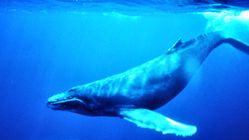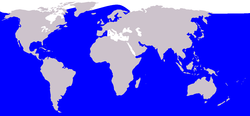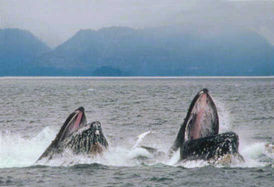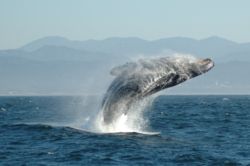Humpback Whale
2007 Schools Wikipedia Selection. Related subjects: Mammals
| iHumpback Whale | ||||||||||||||||||
|---|---|---|---|---|---|---|---|---|---|---|---|---|---|---|---|---|---|---|
  Size comparison against an average human
|
||||||||||||||||||
|
|
||||||||||||||||||
| Scientific classification | ||||||||||||||||||
|
||||||||||||||||||
|
|
||||||||||||||||||
| Megaptera novaeangliae (Borowski, 1781) |
||||||||||||||||||
 Humpback Whale range
|
The Humpback Whale, Megaptera novaeangliae, is a mammal which belongs to the baleen whale suborder. It is a large whale: an adult usually ranges between 12–16 m (40–50 ft) long and weighs approximately 36,000 kg (79,000 pounds), or 36 tonnes (40 short tons); females, on average, are larger than males. It is well known for its breaching (leaping out of the water), its unusually long front fins, and its complex whale song. The Humpback Whale lives in oceans and seas around the world, and is regularly sought out by whale-watchers.
Feeding
The species feeds only in summer and lives off fat reserves during winter. It is an energetic feeder, taking krill and small schooling fish, such as herring, capelin and sand lance. It will hunt fish by direct attack or by stunning them by hitting the water with its flippers or flukes.
Its most inventive feeding technique is called bubble net fishing. A group of whales will blow bubbles while swimming to create a visual barrier against fish, while one or more whales in the group make vocalizations that drive the fish against the wall. The bubble wall is then closed, encircling the fish, which are confined in an ever-tighter area. The whales then suddenly swim upwards and through the bubble net, mouths agape, swallowing thousands of fish in one gulp. This technique can involve a ring of bubbles up to 30 m (100 ft) in diameter and the cooperation of a dozen animals at once. It is perhaps the most spectacular act of cooperation among marine mammals.
Humpback Whales are preyed upon by orcas. The result of these attacks is generally nothing more serious than some scarring of the skin. However, it is likely that young calves are sometimes killed.
Whale song
Alongside its aerial acrobatics, the Humpback Whale is well known for its long and complex "song". As cetaceans have no vocal chords, whales generate their songs by forcing air through their massive nasal cavities. Humpbacks repeat patterns of low notes that vary in amplitude and frequency in consistent patterns over a period of hours or even days. Scientists are still unsure what whalesong is meant to communicate. Only male Humpbacks sing, so it was at first assumed that the songs were solely for courting. While the primary purpose of whalesong may be to attract females, it's almost certain that whalesong serves myriad purposes. Also interesting is the fact that a whale's unique song slowly evolves over a period of years —never returning to the same sequence of notes even after decades.
During the feeding season, Humpback Whales make altogether different vocalizations used to scare fish into their bubble nets.
Population and distribution
The Humpback Whale is found in all the major oceans, in a wide band running from the Antarctic ice edge to 65° N latitude. It is a migratory species, spending its summers in cooler, high-latitude waters, but mating and calving in tropical and sub-tropical waters. Annual migrations of up to 25,000 km (16,000 statute miles) are typical, making it one of the best-travelled of any mammalian species. An exception to this rule is a population in the Arabian Sea, which remains in these tropical waters year-round. The species is not found in the eastern Mediterranean, the Baltic Sea or the Arctic Ocean.
Internationally this species is considered vulnerable. Specific countries are creating action plans to protect this whale; for example in the UK the Humpback Whale has been designated as a priority species under that nation's Biodiversity Action Plan, generating a specific set of actions to conserve this species.
Whaling
The first recorded Humpback kill was made in 1608 off Nantucket. Opportunistic killing of the species is likely to have occurred long before then, and certainly continued with increasing pace in the following centuries. By the eighteenth century, the commercial value of Humpback Whales had been realized, and they became a common prey of whalers for many years.
By the 19th century, many nations (in particular, the United States), were hunting the creature heavily in the Atlantic Ocean — and to a lesser extent in the Indian and Pacific Oceans. However, it was the introduction of the explosive harpoon in the late nineteenth century that allowed whalers to accelerate their take. This, coupled with the opening-up of the Antarctic seas in 1904, led to a sharp decline in whale numbers amongst all populations.
It is estimated that during the 20th century at least 200,000 Humpbacks were taken, reducing the global population by over 90%. To prevent species extinction, a general moratorium on the hunting of Humpbacks was introduced in 1966 and is still in force today. In his book Humpback Whales (1996), Phil Clapham, a scientist at the Smithsonian Institute, says "this wanton destruction of some of the earth's most magnificent creatures [is] one of the greatest of our many environmental crimes".
By the time the International Whaling Commission members agreed on a moratorium on Humpback hunting in 1966, the whales had become sufficiently scarce as not to be worthwhile hunting commercially. At this time, 250,000 were recorded killed. However, the true toll is likely to be significantly higher. It is now known that the Soviet Union was deliberately under-recording its kills; the total Soviet Humpback kill was reported at 2,710 whereas the true number is now believed to be 48,000.
As of 2004, hunting of Humpback Whales is restricted to a few animals each year off the Caribbean islands of St. Vincent and the Grenadines. The take is not believed to threaten the local population.
Starting in 2007 Japan is planning to kill 50 Humpback Whales per year under its JARPA-II research program.
Whale-watching
Humpback Whales are generally curious about objects in their environment. They will often approach and circle boats. Whilst this inquisitiveness was akin to suicide when the vessel was a whaling ship, it has become an attraction of whale watching tourism in many locations around the world since the 1990s.
Whale-watching locations include the Pacific coast off Oregon, Washington, Vancouver, Hawaii and Alaska, the Bay of Biscay to the west of France, Byron Bay north of Sydney, Hervey Bay north of Brisbane, the coasts of New England and Newfoundland, New Zealand, the Tongan islands, the northern St. Lawrence River and the Snaefellsnes peninsula in the west of Iceland. The species is popular because it breaches regularly and spectacularly, and displays a range of other social behaviours.
As with other cetacean species, however, a mother whale will generally be extremely protective of her infant, and will seek to place herself between any boat and the calf before moving quickly away from the vessel. Whale-watching operators are asked to avoid stressing the mother unduly.
An albino Humpback Whale that travels up and down the east coast of Australia has become famous in the local media there, on account of its extremely rare all-white appearance. The whale, born in 1990, is called Migaloo (the Aboriginal word for "white lad"). Many years of speculation about the whale's gender were resolved in June 2004, when it found a mate for the first time, and was proven indisputably male. Because of the intense interest, environmentalists feared that the whale was becoming distressed by the number of boats following the creature each day. In response, the Queensland government ordered the maintenance of a 500-metre exclusion zone around the whale.
Research
Although much was known about the size, shape, and composition of Humpback Whales due to whaling, the migratory patterns and social interactions of the species were not well known until the problem was analysed by R. Chittleborough and W. H. Dawbin in two separate studies in the 1960s. Roger Payne and Scott McVey studied the species in 1971.
Their analysis of the whale song led to worldwide media interest in the species, and left an impression in the public mind that whales were a highly intelligent species, a contributing factor to the anti-whaling stance of many countries. Some scientists (see Mercado) have hypothesized that the song may serve an echolocative function.
Scientists realised that the varying patterns on the Humpback's tail fluke were sufficient to identify an individual. Such unique identification is not possible in other species (except some groupings of orcas, notably in the Pacific Northwest), and so the Humpback has become one of the most-studied whale species. A study using data from 1973 to 1998 on whales in the North Atlantic gave researchers detailed information on gestation times, growth rates, and calving periods — as well as allowing accurate population predictions by simulating the mark-release-recapture technique. A photographic catalogue of all known whales in the North Atlantic was developed over this period and is today maintained by Wheelock College ( here). Similar photographic identification projects have subsequently begun in the North Pacific, specifically by SPLASH (Structure of Populations, Levels of Abundance and Status of Humpbacks), as well as in other areas around the world.
Humphrey
Probably the most famous Humpback Whale is Humphrey the whale, who was rescued twice by The Marine Mammal Centre and other concerned groups. The first rescue was in 1985, when he swam into San Francisco Bay and then up the Sacramento River. Five years later, Humphrey returned and became stuck on a mudflat in San Francisco Bay immediately north of Sierra Point below the view of onlookers from the upper floors of the Dakin Building. He was pulled off the mudflat with a large cargo net and the help of a Coast Guard boat. Both times he was successfully guided back to the Pacific Ocean using a "sound net" in which people in a flotilla of boats made unpleasant noises behind the whale by banging on steel pipes, a Japanese fishing technique known as "oikami." At the same time, the attractive sounds of Humpback Whales preparing to feed were broadcast from a boat headed towards the open ocean. Since leaving the San Francisco Bay in 1990 Humphrey has been seen only once, at the Farallon Islands in 1991.
In popular culture
In Moby-Dick, a novel where the chief whale protagonist is a Sperm Whale, Herman Melville describes the Humpback Whale as "the most gamesome and light-hearted of all the whales, making more gay foam and white water than any other of them".
The extinction of Humpback Whales was a plot element of the film Star Trek IV: The Voyage Home. In the film, an alien space probe arrives at 23rd century Earth and attempts to contact the whales, which are discovered to have been an intelligent species. However, since the whales became extinct in the 21st century (according to Spock), the probe's attempts at communication fail; increasingly stronger efforts by the probe to make contact prove destructive to Earth. In order to prevent this, the crew of the Enterprise uses a stolen Klingon starship to travel back in time to the 20th century and obtain a breeding pair of Humpbacks to communicate with the probe and forestall the Earth's destruction. In the novelization of this movie, the Chekov character refers to the humpback whale by the Russian term "vessyl kit", apparently meaning "merry whale"- an indirect tribute to Melville's description.
Judy Collins' 1970 album Whales and Nightingales featured a recording of the traditional song "Farewell To Tarwathie", on which Collins sang to the accompaniment of a recording of a humpback whale.
In Disney's Fantasia 2000, a segment featuring a pod of frolicking Humpback Whales in an unusual 'aerial' setting, and within icebergs is set to Ottorino Respighi's Pines of Rome.
In Disney/Pixars Finding Nemo, a humpback whale guides Marlin and Dory to Sydney, Australia.
A breaching Humpback Whale serves as the logo for the Pacific Life insurance company.





